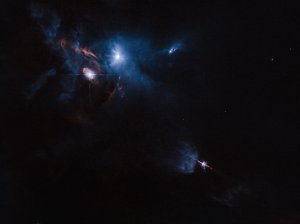

The Atacama Large Millimeter/Submillimeter Array (ALMA), which is known for its high degree of sensitivity, has outdone itself once again. In an incredible new image that could easily be the best science image of the year, ALMA has captured — in submillimeter wavelengths — a protoplanetary disk in unprecedented detail. This is definitely an instance where the actual image far surpasses any artistic rendition, and these new findings could shake up what we know about how protoplanetary disks, and even planets, form.
As detailed as this image is, ALMA is still in its test phase, and we can expect many more images of this caliber to come. Researchers set ALMA’s sights on a young star, approximately 450 light-years from Earth, HL Tauri. This star system is shrouded by a disk of gas and dust, which appears to be more developed than one would expect such a young system to have (this is unusual, but certainly not unheard of).
“When we first saw this image we were astounded at the spectacular level of detail. HL Tauri is no more than a million years old, yet already its disk appears to be full of forming planets. This one image alone will revolutionize theories of planet formation,” explained Catherine Vlahakis, ALMA Deputy Program Scientist and Lead Program Scientist for the ALMA Long Baseline Campaign.

Meet HL Tauri:
HL Tauri has proven to be an interesting star to observe. In regions of gravitational collapse, stars like HL Tauri develop in the surrounding clouds of gas and dust. Super-heated, dense cores coalesce, and eventually start fusing light elements into heavier elements in said core, entering main sequence mode. At first, they are comfortably nestled in cocoon of interstellar material, but the excess soon flattens out into a disk known as a proplyd (or a protoplanetary disk). Contrary to other stars in its age group, the proplyd surrounding HL Tauri, is highly-developed, which could signal that the young star is already in the planet formation stage.
According to our current understanding of planet formation, the process begins when dust particles within a disk start to collide, and clump together. Over time, said clumps will eventually accumulate enough material that gravity kicks in and the clumps take shape, forming celestial bodies like planets, comets, and even asteroids. Developing planets are known to perturb the gas — and most noticeably, the dust — surrounding the star, leaving large, distinguishable concentric rings in the surrounding disk. These distinct rings, in turn, are separated by darker gaps — places where embryonic planets develop.
“These features are almost certainly the result of young planet-like bodies that are being formed in the disk. This is surprising since such young stars are not expected to have large planetary bodies capable of producing the structures we see in this image,” said Stuartt Corder, ALMA Deputy Director.
As an interesting side-note, these constructs aren’t exclusive to protoplanetary disks. In fact, we’ve seen similar things, known as “Kirkwood gaps,” much closer to home; with Jupiter. Specifically, the gaps are a consequence of orbital resonance (the path in which two large objects carve out when they are mutually engaged in a regular, periodic orbital dance). This same phenomenon is related to everything from the concentration of asteroids in the asteroid belt, to harmony amongst Jupiter’s many moons.
Take Saturn’s F-ring, for proof of concept. Two of its small moons — Prometheus and Pandora — are often referred to as ‘shepherding moons’ because, as they travel along their unchanging orbital paths, they plow through any new material that would otherwise contribute to the ring’s width, consequentially keeping it thinned out.
What’s Next?
Further observations are needed to determine if there are indeed infant planets forming in each gap. The distinct ring structure could be difficult to maintain based solely on resonance, and scientists would expect to see more of a spiral structure (versus separate rings) if there were no planets. So, for now, how many planets HL Tauri does have, or will host, remains a mystery.

These observations are integral to our understanding of how planets form regardless. Being able to capture the first moments of a planet’s “life” will ultimately teach us more about our own planet; how it developed; and perhaps even what it looked like over four billion years ago.
“Most of what we know about planet formation today is based on theory. Images with this level of detail have up to now been relegated to computer simulations or artist’s impressions. This high resolution image of HL Tauri demonstrates what ALMA can achieve when it operates in its largest configuration and starts a new era in our exploration of the formation of stars and planets,” says Tim de Zeeuw, Director General of ESO.
You can read the full press release here.